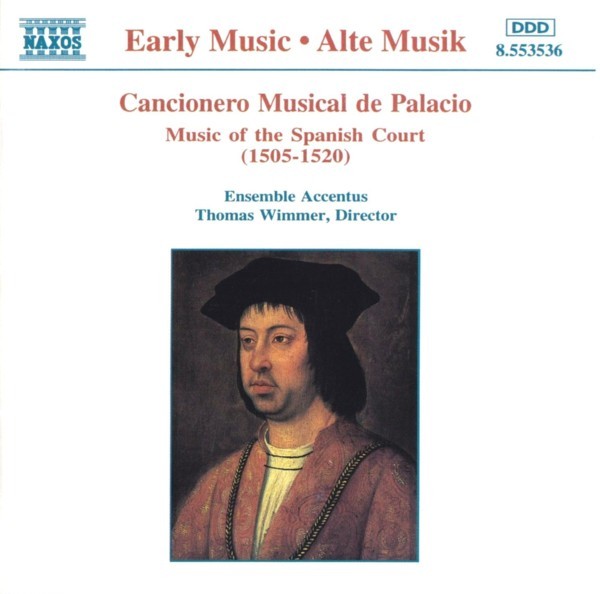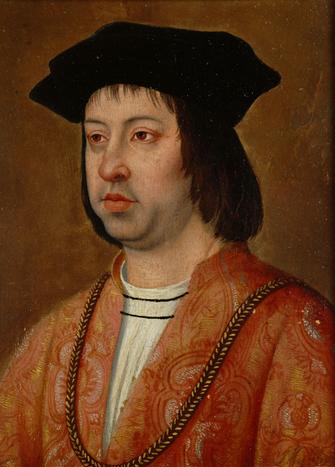
naxos.com
Naxos Early Music · Alte Musik 8.553536
1996

naxos.com
Naxos Early Music · Alte Musik 8.553536
1996
01 - Rodrigo Martínez [2:11]
02 - Juan de ANCHIETA (1462-1523). Con amores, mi madre (instr.) [2:34]
03 - Juan del ENZINA (1468-1529). Pues que jamás olvidaros [5:50]
04 - Juan del ENZINA. Si abrá en este baldrés [1:28]
05 - Si d'amor pena sentís [4:38]
06 - ALONSO (c.1460-c.1520). Tir'allá, que non quiero [2:50]
07 - LOPE de BAENA (c.1460-c.1520). Todo quanto yo serví (instr.) [2:21]
08 - Juan del ENZINA. Levanta Pascual [2:53]
09 - BADAJOZ (fl.c.1520). Malos adalides fueron [5:01]
10 - Juan del ENCINA. Todos los bienes del mundo (instr.) [3:02]
11 - Francisco MILLÁN (fl.c.1500). Durandarte [3:23]
12 - Juan del ENCINA. Fata la parte [2:00]
13 - Juan del ENCINA. Pedro, i bien te quiero [3:01]
14 - Francisco de la TORRE (1460-1505). Danza alta (instr.) [1:43]
15 - Juan del ENCINA. ¿Qu'es de ti, desconsolado? [3:42]
16 - ALONSO. La tricotea [3:28]
17 - Ay triste, que vengo [2:03]
18 - So ell enzina (instr.) [1:50]
19 - Juan PONCE (c.1480-after 1521). Como está sola mi vida [2:18]
20 - O voy (instr.) [1:44]
21 - Tres morillas m'enamoran [4:54]
22 - Juan del ENZINA. Hoy comamos y bebamos [4:07]
Ensemble Accentus
Thomas Wimmer
Carmen Cano, mezzo-soprano
Bernhard Landauer, countertenor
Bernd Lambauer, tenor
James Curry, tenor
Colin Mason, bass-baritone
Marco Ambrosini, keyed fiddle, gaitita
Nora Kallai, viola da gamba
Lorenz Duftschmid, viola da gamba, violone
Thomas Wimmer, viola da gamba, violone, vihuela d'arco, ud, gaitita
Michael Posch, Renaissance recorder
Riccardo Delfino, harp, double harp, hurdy gurdy, gaita
Richard Labschütz, vihuela da mano
Wolfgang Reithofer, percussion
Recorded by W*A*R
Studio at the Lutheran Stadtpfarrkirche A.B., Vienna,
from 9th to 12th May, 1995.
Engineers: Elisabeth and Wolfgang Reithofer

Cancionero Musical
de Palacio
Im Jahre 711 setzten arabische Truppen von Nordafrika zur lberischen
Halbinsel über und etablierten in wenigen Jahrzehnten ein neues
islamisches Reich, das beinahe das gesamte heutige Spanien
umfaßte. Zusammen mit den Arabern kamen etwa 50.000 Juden, deren
Zahl im Laufe der Jahrhunderte weiter anwuchs. Der Widerstand der
christlichen Bevölkerung gegen die Fremdherrschaft begann sich
zwar schon ab dem 13.Jhdt. merkbar zu regen, dennoch sollte es bis zum
Jahre 1492 dauern, bis durch die Eroberung Granadas - des letzten
maurischen Königreichs - die gesamte lberische Halbinsel wieder
unter christliche Herrschaft gestellt wurde. In den nahezu acht
Jahrhunderten davor, vermischten sich die drei Bevölkerungsgruppen
- Araber, Christen und Juden - nie wirklich, es bestand jedoch
genügend Zeit, einzelne Kulturelemente gegenseitig zu
übernehmen, bzw. auszutauschen. 1492 wurde diesem
Befruchtungsprozeß ein jähes Ende gesetzt: den Fall Granadas
nahm man als willkommenen Anlaß, sämtliche nichtbekehrte
Juden des Landes zu verweisen und, unterstützt durch die
Inquisition, den Katholizismus zur Staatsreligion zu erheben. Mehrere
kritische Autoren der Zeit bemerkten sehr wohl den kulturellen Verlust
und die geistige Verarmung, die Spanien durch diese Ereignisse erfuhr.
Die Unterstützung Columbus' und die folgenden Bemühungen in
Übersee katholische Vizekönigreiche zu etablieren, boten in
weiterer Folge scheinbar eine mehr als willkommene Gelegenheit, von den
eigentlichen Problemen des Landes abzulenken.
In der Kunstmusik vollzog sich Ende des 15.Jhdts. ein entscheidender
Wandel: suchten die spanischen Herrscher bisher ihre Musiker in
Frankreich, Flandern oder Italien, so engagierten die "Katholischen
Könige" Isabella und Ferdinand (ihre Heirat im Jahre 1469 vereinte
die Königreiche Kastilien und Aragon, die Thronbesteigung fand
1474 statt) lediglich Spanier für ihre Orchester. Vorallem
Ferdinand war es, der nach dem Tod Isabellas 1504 die besten
kastilischen Musiker an seinen Hof berief und die "Capella Reyal", die
Königliche Kapelle gründete, die mit ihren sechsundvierzig
Musikern eine der größten in Europa war. Durch diese
Bewußtwerdung der eigenen Kultur und Fähigkeiten wurde in
der Folge dem intellektuellen franko-flämischen Stil des
frühen 15.Jhdts. ein davon völlig abweichender
gegenübergestellt. Dieser neue Stil, der sich stark an der
Volksmusik orientierte und auf einem einfacheren harmonikalen Aufbau
basierte, brachte aber keineswegs eine Vereinfachung und ein Abgleiten
ins Banale, sondern eine unvergleichliche Emotionalität und
Ausdruckskraft. Nichtmehr die Kontrapunktik stand im Mittelpunkt des
Interesses, sondern die Textausdeutung auf einer reinen
Gefühlsebene. Trotz aller Rückbesinnung auf das originär
Christlich-Spanische, findet man aber gerade hier die Spuren jener
Kulturen wieder, derer sich Spanien eigentlich entledigen wollte, die
die Bevölkerung jedoch nicht nur in musikalischen Belangen so
nachhaltig tief geprägt haben. Die der Musik innewohnende
Melancholie, die Rhythmik, die Form und der Inhalt vieler Lieder zeugen
deutlich von der Präsenz der Juden und Araber.
Als Quellen des höfischen Repertoires dienen uns heute mehrere als
Cancioneros bezeichnete Liedersammlungen, die bedeutendste
darunter, der Cancionero Musical de Palacio. Er findet sich in
Madrid in der Biblioteca del Real Palacio und umfaßte
ursprünglich 551 Kompositionen, wovon durch den Verlust von 54
Blättern, 460 erhalten sind. Die Enstehungszeit dieses
umfangreichsten Zeugnisses spanischen Musiklebens fällt in das
letzte Drittel des 15., bzw. in das erste Drittel des 16.Jhdts. Mit
großer Sicherheit wurde diese Sammlung nicht von einem, sondern
von mehreren Schreibern verfaßt, die das Notenmaterial sehr
exakt, die Texte jedoch oft fehlerhaft und mit phonetischen
Verwechslungen widergaben. Im Original stehen die Lieder nicht als
Partitur, sondern sind, wie auch im restlichen Europa des 15.und
16.Jhdts. üblich, als einzelne Stimmen abgedruckt, wobei der Text
zumeist nur dem Diskant unterlegt ist. Der Cancionero dürfte zwar
schon zur Entstehungszeit der Königlichen Kapelle gedient haben,
viele Gedichte stammen jedoch aus der Umgebung des Herzogs von Alba.
Der Inhalt der Lieder ist vielfältig: Liebesgeschichten,
politische und historische Ereignisse (darunter immer wieder die
Thematik der Eroberung Granadas), Religiöses, Ritterliches,
pastorale Themen, scherzhafte Streiche bis hin zu tanzbaren
Musikstücken. Kastilian findet sich bei weitem als häufigste
Sprache, in geringerem Ausmaß scheinen italienische,
portugiesisch und sogar baskische Texte auf, sowie typischerweise
Lieder in einer französich-italienisch-kastilischen Mischsprache.
Die häufigsten Formen sind der, der Volksmusik nahestehende villancico
und die romance. Der villancico zeigt Ähnlichkeiten mit
der italienischen frottola und dem arabischen zejel,
entstand vermutlich im 14.Jhdt. und wurde bis weit ins 16.Jhdt. hinein
verwendet und ausgebaut. Es handelt sich dabei um eine strophische
Liedform, welche stets mit einem Eingansvers (estribillo)
beginnt, mit der eigentlichen Strophe (copla) fortsetzt und in
der vuelta zur Ausgangsmelodie zurückkehrt. Die romance
hingegen ist in einem viel breiter angelegten Erzählstil
abgefaßt und berichtet eposartig von Liebesgeschichten oder
Ritterthemen.
Der Kompositionsstil der Lieder ist einigermaßen uneinheitlich
und reicht von fugenartiger Durchführung über einfache
Homophonie zu totaler Textexpression, von dreistimmiger
Discantus-Tenor-Contratenor-Technik des 15.Jhdts., zu sechsstimmiger
Polyphonie, die weit ins 16.Jhdt. hineinweist.
Alles in allem zeigt uns der Cancionero de Palacio das
Aufblühen des spanischen Kulturlebens, ermöglicht durch ein
erstarktes Selbstbewußtsein und Nationalitätsgefühl,
gefördert durch stets wachsende Handelskontakte mit Flandern und
Ubersee, und gekennzeichnet durch Schlichtheit, emotionale Tiefe und
die Verflechtung höfischer Kunst mit Volkstümlichem.
© 1996 Thomas Wimmer

In the year 711 Arab armies from North Africa crossed into the Iberian
peninsula and in a few decades established there a new Islamic kingdom
that included nearly all present-day Spain. Together with the Arabs
came some 50,000 Jews, whose numbers increased during the course of the
century. The opposition to foreign domination began to make itself felt
from the thirteenth century, continuing until 1492 when Granada was
taken, the last Moorish kingdom, and the whole Iberian peninsula passed
again under Christian suzerainty. In the almost eight preceding
centuries there had been a mixture of the three groups of people,
Arabs, Christians and Jews, with a consequent exchange of some cultural
elements. In 1492 this stimulating process came to a sudden end. The
fall of Granada was taken as a welcome reason to exile the unconverted
Jews, and, with the help of the Inquisition, to impose Catholicism as a
state religion. More critical authors of the period were well aware of
the cultural loss and the spiritual impoverishment that Spain underwent
through these events. The support for Columbus and the subsequent
attempts to establish overseas the Catholic Vice-Regal dominion
offered, it seemed, a more than welcome opportunity away from the
particular problems of the country.
The end of the fifteenth century brought a definite change in art
music. Before this the Spanish rulers had looked for musicians in
France, Flanders or Italy, but the Catholic court, under Ferdinand and
Isabella, whose marriage in 1462 had united the kingdoms of Aragon and
Castile, with their accession to the throne in 1474, engaged only
Spanish musicians for their orchestra. Above all it was Ferdinand who,
after the death of Isabella in 1504, invited the best Castilian
musicians to his court and founded the royal chapel, one of the largest
in Europe, with 46 musicians. Through this development of awareness of
their own culture a style developed different from the Franco-Flemish
style of the early fifteenth century. This new style, strongly oriented
towards folk-music and based on a simpler harmonic structure, brought
in no way a simplification or descent into the banale, but rather an
incomparable strength of feeling and expression. Counterpoint no longer
held the main point of interest, but, instead, the sensitive expression
of the text. Rather than looking back to original Christian Spain, here
there are traces of that culture of which Spain wanted to be rid, that
had made such a deep impression on the people, not only in music. The
inner melancholy of the music, the rhythm, the form and the contents of
many songs are evidence of the presence of Jews and Arabs.
Several so-called Cancioneros serve us today as sources of the
court repertoire, collections of songs, among which the most important
is the Cancionero de Palacio. This is found in the library of
the Royal Palace in Madrid and originally included 551 compositions, of
which, through the loss of 54 pages, 460 are preserved. The origin of
this very substantial witness to the musical life of Spain falls in the
last third of the fifteenth century and in the first third of the
sixteenth. It is certain that this collection is not the work of one
but rather of several scribes, who copied the notation very exactly,
but made many mistakes and phonetic changes in the texts. In the
original the songs are not given in score but are, as in the rest of
Europe at this period, given in separate parts, with the text only
underlying the discant. The Cancionero must certainly have
served at the establishment of the Royal Chapel, although many poems
stem from the entourage of the Duke of Alba.
The songs included are of many different kinds, love stories, political
and historical narratives (among them ever again the theme of the
capture of Granada), religious, knightly and pastoral subjects,
light-hearted pieces and dance music. Castilian is by far the most
frequent language, with a smaller quantity of texts in Italian,
Portuguese and even Basque, as well as typical songs in a mixture of
French, Italian and Castilian. The most frequent forms are those of the
villancico and the romance. The former has similarities
with the Italian frottola and the Arab zejel, with its
probable origin in the fourteenth century and continuing in use well
into the sixteenth. It is a strophic form, which always begins with an
introductory verse (estribillo), continuing with an original
strophe (copla) and ending with the vuelta. The romance,
on the other hand, is in more general narrative style, dealing with
stories of love or knighthood.
The compositional style of the songs is not unified and ranges from
fugal writing to simple homophony and complete expression of the text,
from the three-voice discant-tenor-contratenor technique of the
fifteenth century to the six-voice polyphony of the sixteenth.
All in all the Cancionero de Palacio shows the flowering of
Spanish cultural life, made possible through a strengthened
self-awareness and feeling of nationhood, developed through
ever-growing trade contact with Flanders and overseas and characterized
by simplicity, emotional depth and the interweaving of court art with
the art of the people.
Thomas Wimmer (English version by Keith Anderson)